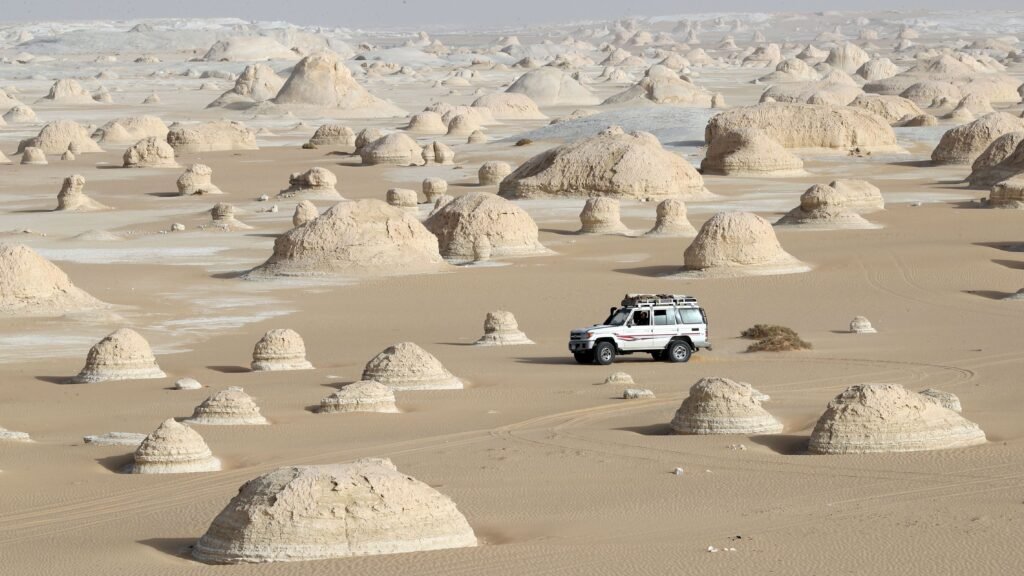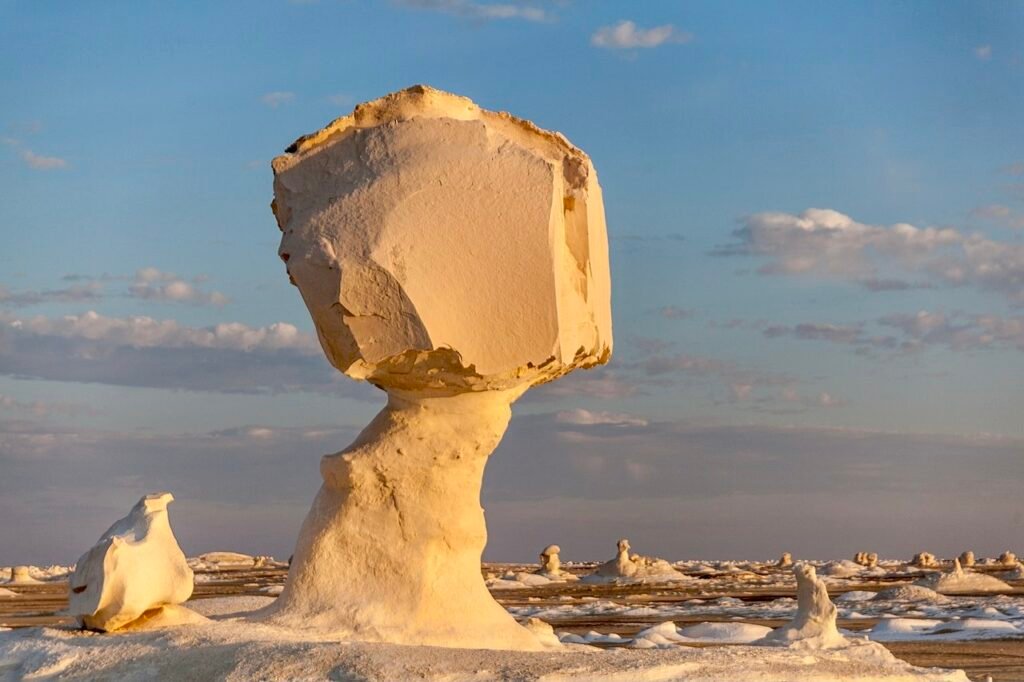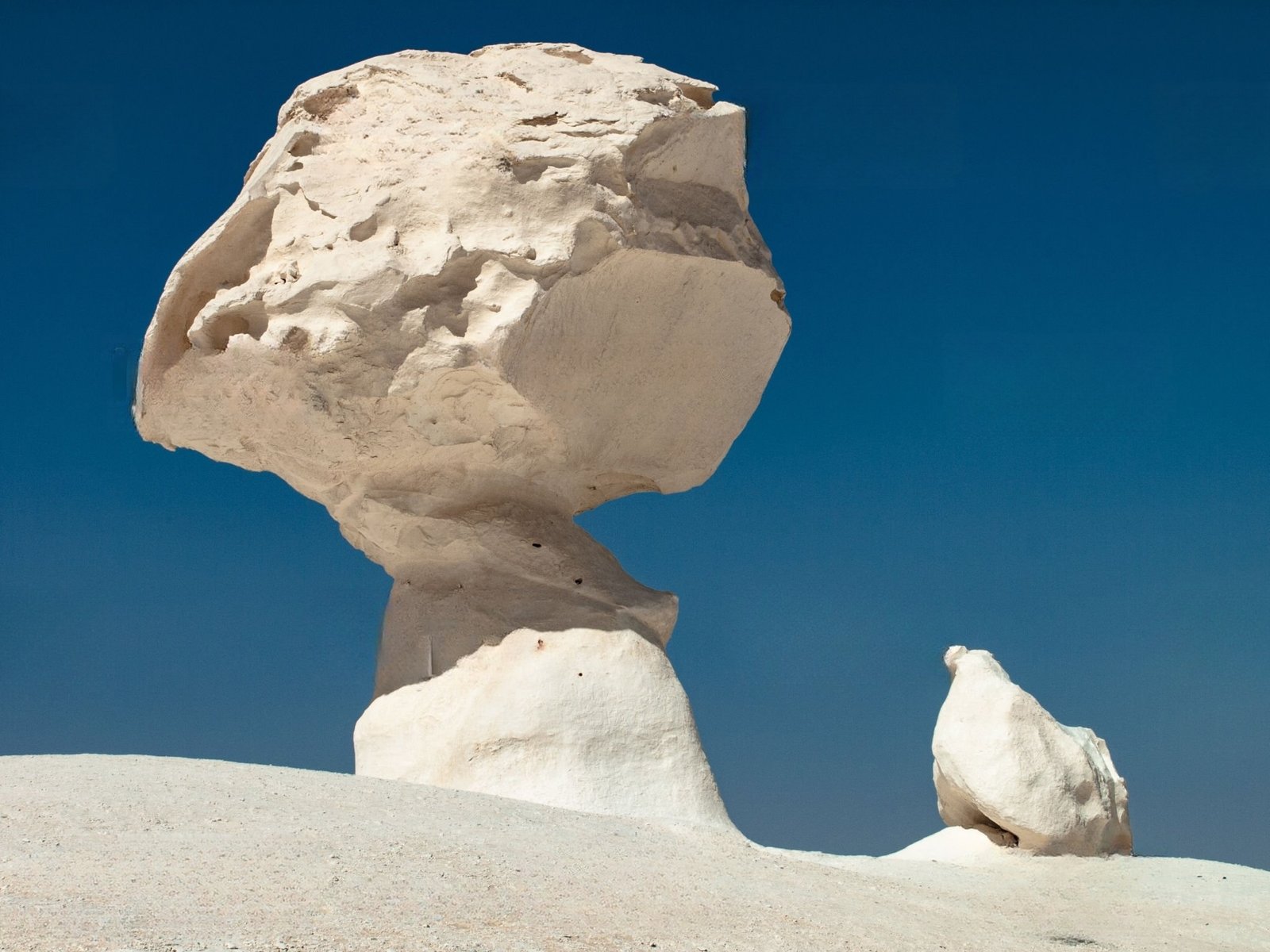Click here to Choose your Next Cheap Tour To Egypt The Price Starts From $25
Introduction
The White Desert National Park, a sprawling spectacle of pristine beauty located in Egypt, is a realm filled with grandeur, mystery, and captivating stories. The stark, alien-like landscapes, intriguing geological formations, and the wilderness that thrives amidst this vast desert offer a unique invitation to explore nature’s unfiltered beauty. In this comprehensive article, we delve into the lesser-known aspects of the White Desert, revealing why this stunning terrain deserves a spot on every adventurer’s bucket list. So, buckle up for an exciting ride through the heart of Egypt’s wild expanse.

White Desert National Park: An Overview
Situated approximately 45 kilometers north of Farafra, the White Desert covers an expansive area within Egypt’s Western Desert. Its name derives from the surreal, chalky white landscapes that contrast strikingly against the endless blue of the sky. Over millions of years, the relentless forces of nature have sculpted the landscape into a living canvas of incredible formations. This natural masterpiece stands as a testament to the artistic prowess of wind and sand.
What sets the White Desert apart is its mesmerizing beauty, which transcends the ordinary. It’s almost as if you’ve stepped into a parallel universe, far removed from the mundane realities of everyday life. Whether you’re an avid adventurer, a curious geologist, or simply a traveler looking for extraordinary experiences, the White Desert offers a compelling allure that is hard to resist.
Geological Wonders of the White Desert National Park
The White Desert National Park is a veritable wonderland for those interested in geology. The desert’s signature white chalk formations, known as yardangs, are a sight to behold. Eroded over eons, these structures have adopted bizarre shapes, mimicking everything from giant mushrooms to camels, and even eerily human-like faces.
One of the highlights is Crystal Mountain, an exquisite formation made of large quartz crystals. Although it’s not a mountain in the traditional sense, this crystal outcrop’s magnificence rivals many peaks. A visit here offers a glimpse into the fascinating geological history etched into the very heart of the White Desert.
The geological charm of the White Desert is not just limited to its surface. The desert also hides a beautiful secret beneath its sands – a rich treasure trove of fossils. From ancient seashells to remnants of prehistoric marine life, these fossils provide clues to a time when this arid land was once submerged under the Tethys Sea.

Wildlife in the White Desert National Park
Against the backdrop of its harsh environment, the White Desert hosts a surprisingly diverse array of wildlife. Adapted to the tough desert conditions, these creatures contribute to the unique ecological character of the park.
One of the most fascinating residents of the desert is the Fennec fox, the smallest species of fox in the world. With their large ears, these creatures are perfectly adapted to the hot desert environment. They’re elusive but spotting one during a safari can be an incredibly rewarding experience.
The Jerboa, another resident of the White Desert, is a small rodent known for its remarkable hopping skills. This nocturnal creature has long hind legs that allow it to leap and hop across the desert surface swiftly, almost like a kangaroo.
Bird watchers are in for a treat as well. The desert is home to various bird species, including resident and migratory birds such as sandgrouses, desert larks, hoopoe larks, and many more.
The White Desert National Park Through the Ages
The captivating charm of the White Desert extends beyond its natural allure, intertwining with human history. The rock art found in several areas of the desert is a testament to this. These prehistoric engravings and paintings offer an insight into the lives of our ancestors who inhabited this region when it was a savannah teeming with life.
The area around the White Desert was once home to early human settlements. The remnants of these communities, visible in the pottery shards and stone tools scattered across the desert, tell tales of a time when the now-desolate landscape bustled with activity.
The area’s modern history is also quite fascinating. The Bedouin tribes who live in and around the White Desert continue to follow their ancient traditions and customs, offering a rare peek into a way of life that has remained largely unchanged for centuries.

White Desert National Park: A Canvas of Colors
One might think of a desert as monotonous, a never-ending expanse of similar-looking landscapes. The White Desert, however, shatters this stereotype with its ever-changing palette of colors.
As daylight wanes, the desert undergoes an enchanting transformation. The chalk-white landscapes take on hues of pink, gold, and orange, reflecting the setting sun’s radiance. Under the moonlight, the desert adorns a ghostly white, lending an ethereal charm to the landscapes. It’s this magical dance of colors that makes a visit to the White Desert National Park a surreal, dreamlike experience.
Cultural Extravaganza: The White Desert National Park Festival
The annual White Desert Festival is a vibrant celebration of the region’s rich cultural heritage. This event, usually held in November, is an amalgamation of music, dance, and traditional cuisine that brings together locals and tourists alike.
Musicians and artists from different Bedouin tribes participate in the festival, showcasing their talent and sharing their cultural narratives. Tourists get to sample traditional Bedouin food, engage in craft workshops, and learn about the Bedouin way of life. The festival is an excellent platform to witness the cultural exchange and unity that the White Desert fosters.

Adventures in the White Desert National Park
For thrill-seekers, the White Desert is a playground. The vast expanse of the desert offers a wealth of adventure activities. From desert safaris to sandboarding and rock climbing, the options are as diverse as the landscapes themselves.
Overnight camping under the star-studded sky is another unforgettable experience the desert offers. With minimal light pollution, the clear desert nights provide a brilliant canvas for stargazing. The sight of the Milky Way stretching across the sky is a spectacle worth witnessing.
The Future of the White Desert National Park
The potential of the White Desert National Park as a prime ecotourism destination is immense. It offers the unique combination of natural beauty, biodiversity, and cultural heritage. Sustainable practices and local community involvement are at the heart of ecotourism, and the White Desert is an ideal location to put these principles into action.
The income from ecotourism can aid in the conservation of this fragile ecosystem and help uplift the local communities. It’s an opportunity to experience and appreciate nature while contributing positively towards its preservation.
Preservation and Conservation: The Stewardship of the White Desert
Safeguarding the integrity of the White Desert National Park has become an urgent necessity. The desert, home to an array of unique geological formations and diverse species, faces threats from various fronts. Unregulated tourism, climate change, and human encroachment have put this invaluable ecosystem at risk.
Active conservation efforts are underway to preserve the park’s natural and cultural heritage. Environmental laws have been implemented to regulate tourism and ensure that the desert’s biodiversity is not compromised. It’s an ongoing mission that requires collective effort and commitment from all stakeholders – from the government and locals to tourists and international organizations.
Eco-Tourism: A Sustainable Approach
Eco-tourism in the White Desert National Park presents a potential path toward sustainable development. It encourages tourists to respect the natural environment and local customs while also contributing to the local economy.
The model of eco-tourism not only helps generate revenue for conservation but also uplifts the local communities by providing them with job opportunities. From acting as local guides to running small businesses that cater to tourists, locals can significantly benefit from a well-regulated tourism industry.
To promote eco-tourism, the management of the White Desert has initiated several measures. These include the creation of designated camping spots to minimize the human impact on the ecosystem and providing eco-tourism training to locals. With the right policies and implementation, eco-tourism can play a pivotal role in the preservation of the White Desert.

The Bedouin Influence: Guardians of the White Desert National Park
The Bedouin tribes have lived in harmony with the White Desert for centuries. They have a deep understanding of the desert ecosystem, passed down through generations. Their traditional ways of life are designed to minimize the impact on the environment, highlighting a model of sustainability that the modern world can learn from.
In recent years, the Bedouins have become active participants in conservation efforts. They use their intimate knowledge of the desert to guide policies and actions that benefit the environment. From acting as park rangers to offering eco-friendly tours, they play a significant role in preserving the White Desert.
Climate Change and the White Desert National Park
Like other ecosystems worldwide, the White Desert National Park is not immune to the impacts of climate change. Changes in temperature and precipitation patterns can disrupt the delicate balance of desert ecosystems, affecting both wildlife and human communities.
Conservation strategies are being adapted to account for these climate-related changes. Efforts are being made to monitor and study the impacts of climate change on the desert’s flora and fauna. These insights can help shape effective management and conservation strategies, ensuring the White Desert’s long-term survival.
The Magic of the Night Sky in the White Desert
The White Desert, with its clear skies and minimal light pollution, is a haven for stargazers. On a clear night, one can see countless stars, planets, and even distant galaxies. The Milky Way, with its dense band of stars, creates a breathtaking celestial display that enchants visitors.
Several stargazing events and astronomy workshops are held in the desert, catering to space enthusiasts and amateurs alike. It’s an opportunity to connect with the cosmos and gain a broader perspective of our place in the universe.
Read more: Unraveling History of Egypt: 20 Fascinating Facts
The White Desert: An Artist’s Paradise
The White Desert National Park has also attracted artists from around the globe, inspired by its surreal landscapes. Its chalk formations serve as natural sculptures, crafted by the wind and sand over millennia.
Artists have used the desert as both a canvas and a muse, creating stunning artworks that capture the desert’s spirit. The annual White Desert Art Festival is a testament to this, showcasing art pieces inspired by the desert and its natural beauty.
The Future of the White Desert: Our Shared Responsibility
The White Desert is more than just a desert; it’s a shared heritage that needs to be preserved for future generations. Each one of us has a role to play in its conservation. By visiting responsibly, supporting local communities, and raising awareness about the desert’s significance, we can ensure that the White Desert continues to captivate and inspire.
Conclusion
The White Desert National Park is a world within itself, offering a unique blend of natural wonders, diverse wildlife, and rich cultural heritage. Its preservation is crucial for maintaining the delicate balance of our ecosystem and promoting sustainable development. As we continue to explore and admire the beauty of the White Desert, let us also commit to its stewardship, ensuring its marvels endure for generations to come.
FAQs
1. What is the best time to visit the White Desert National Park?
The best time to visit the White Desert National Park is during the cooler months between October and April. This period offers the most comfortable temperatures for exploration and camping.
2. What activities can one engage in at the White Desert National Park?
Visitors can partake in several activities such as desert safaris, sandboarding, rock climbing, camping, stargazing, and attending cultural festivals.
3. What wildlife can one spot in the White Desert National Park?
The park is home to a variety of wildlife, including Fennec foxes, Jerboas, and various bird species like sandgrouses and desert larks.

